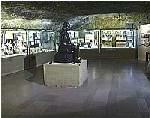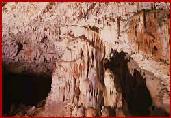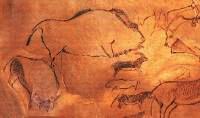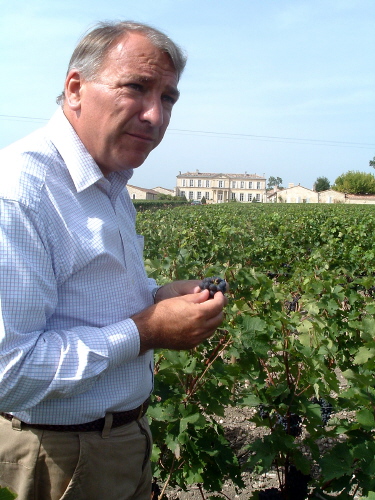
ABRI PATAUD
[Les Eyzies-de-Tayac, Périgord Noir] - Perhaps not well known
to tourists, this site provides evidence that Cro-Magnon man occupied it
many times between 35,000 and 18,000 BC. The three periods of settlement
in that timeframe are known as Aurignacian, Périgordian
and
Solutrean. The excavation work revealed layers to a depth of
about 30 feet, and artifacts were extracted which are on display at the
site museum. On the ceiling of the rock shelter in the museum is
a bas relief of an ibex in remarkable condition dating back to the
Solutrean period around 17,000 years BC.
LA MADELEINE
[Tursac,
Périgord Noir]- As mentioned at the beginning of this article,
this site gave its name to those artistic people, the Magdalenians.
Excavated in 1928 by Denis Peyrony and Dr Capitan, this is a troglodyte
village whose dwellings have been occupied from prehistoric times through
the Middle Ages and into the 20th century! It is said that prehistoric
man lived in the paleolithic site by the river from 12,000 to 8,000 BC,
and modern man occupied the troglodyte dwellings up higher in the cliffs
from medieval times. In the 15th century, a chapel was built precariously
on the cliffside, at the same time a castle was built for defense, the
ruins of which remain today on the plateau above the chapel.

LA GROTTE
DES MERVEILLES [Rocamadour, Lot/Haut Quercy] - Although famous
for the town's cliff-hanging position and as a pilgrimage site, Rocamadour
is also home to la Grotte des Merveilles, discovered the 16th of
October 1920 and classified as an historic monument in May of 1925.
It is only 100 meters distant from the town's tourist office, and visitors
will appreciate beautiful rock formations and paintings created nearly
20,0000 years ago. The cave art was accomplished by the light of
stone lamps burning animal fat, and the art itself is that of horses, stags,
bear and traces of human hands.
PARC ARCHÉOLOGIQUE
DE BEYNAC [Beynac, Périgord Noir] - This outdoor museum, open
from mid-June to mid-September each year, offers visitors a glimpse into
the lifestyle, vocations and crafts of peoples living in the Beynac area
from 6000 BC to 50 BC, ~ they say from the Néolithique to
the Gaulois.
Iron-age implements, a forge, a pottery, greniers built
on stilts to store grain, and much more depict the agricultural society
of those times. All efforts have been made to re-create the structures
and the artifacts very authentically. The making of bronze wares
and implements, pottery-making, the cultivation of plants, fire-making
techniques, and much more are demonstrated for visitors.
 NIAUX
CAVE [Niaux, Ariège] - Back in the Summer of 2000, this newsletter
featured an article by Kim Chevalier on her visit to the Niaux Cave.
The main attraction is the Grand Atelier containing the reproductions not
only of cave drawings but also a replica of children's footprints in the
floor of a cave not open to the public. Another interesting
feature is a model of the main passageways and chambers of the cave with
human figures to give it scale. The Salon Noir, the largest chamber,
brought silence to the visitors because of the superb drawings of bison,
reindeer, ibex and horses ~ another magnificent site to bring us closer
to the history of humankind. NIAUX
CAVE [Niaux, Ariège] - Back in the Summer of 2000, this newsletter
featured an article by Kim Chevalier on her visit to the Niaux Cave.
The main attraction is the Grand Atelier containing the reproductions not
only of cave drawings but also a replica of children's footprints in the
floor of a cave not open to the public. Another interesting
feature is a model of the main passageways and chambers of the cave with
human figures to give it scale. The Salon Noir, the largest chamber,
brought silence to the visitors because of the superb drawings of bison,
reindeer, ibex and horses ~ another magnificent site to bring us closer
to the history of humankind.
OTHER PREHISTORIC
SITES: We aren't going to list all 142 French sites, 24 of which
are open to public viewing, but others to consider visiting are
-
Combarelles (in
Les Eyzies-de-Tayac) caves and engravings
-
Font de Gaume
(in Les Eyzies-de-Tayac) caves and paintings
-
St Cirq du Bugue
- cave of witches, engravings, museum
-
Grotte du Grand
Roc - caves and abysses
-
Gouffre de Proumeyssac
- abyss
-
Grotte de la Halle
(Domme) - cave [open only on specific days]
-
Museum:
in Le Bugue the Musée de Paléontologie
-
Grotte de Peche
Merle (Lot)
[Photos
courtesy of each site's information office. All Rights Reserved]

FRENCH WINE
REPORT:
Weekend at a Bordeaux
chateau with gentleman winemaker Patrick Maroteaux
by Panos Kakaviatos for FRANCE On Your Own
Driving
along the route des châteaux among the great hilly vineyards
of Bordeaux’s Left Bank, a signpost just before the centrally located appellation
of St. Julien welcomes you with a hearty Salut! Many wine
writers note that St. Julien is also centrally located in terms of taste
– the quintessential Left Bank Bordeaux, combining the more robust style
of Cabernet Sauvignon-dominated wine just several miles north in Pauillac
with the silkier, more elegant Cabernet-dominated blends from the Margaux
appellation to the south.
One
of the first châteaux you see on your left, atop a hill just after
passing the signpost in St. Julien, is Château Branaire Ducru,
classified a “fourth growth” in France’s historic 1855 classification of
Bordeaux Left Bank wines. The Left Bank alludes to the strip of land to
the left of the Gironde River known as the Médoc, itself a larger
appellation, which includes Margaux, St. Julien, Pauillac and St. Estephe.
While most all Bordeaux wine is mainly a blend of Cabernet Sauvignon and
Merlot, the Left Bank tends to favor Cabernet Sauvignon.
On assignment
to write about France’s current wine crisis and how Bordeaux has been reacting
to it, nothing prepared me for the warm welcome I received from Branaire
Ducru director and co-owner Patrick Maroteaux who, with his wife Evelyn,
planned an action packed weekend for me.
The first
thing we did upon my arrival one Friday evening in early September was
eat a sumptuous feast of tournedos de boeuf at the Lion d’Or in
Arcins, just outside of Margaux, where every château has its stock
of wine – and most customers bring their own.
The French
daily Le Figaro had just written an article about chef Jean-Paul
Barbier, who greeted us with his wife, Michelle (Mimi). They were in good
spirits, though he talked somewhat bitterly about how too many young people
in the restaurant industry see their work more as a laborious chore rather
than as a noble profession.
We enjoyed
two fine vintages of Patrick’s wine with the dinner: a 1998 Branaire Ducru
(a bit tight, but full of character), followed by a just opening and finely
textured 1996. The meal began with a foie gras, with toasts, which
was delicious. The tournedos were savory with the béarnaise sauce,
and I particularly enjoyed the fricassee de ceps, as the cep season
had just begun, Patrick explained.
Patrick
stressed that Barbier’s restaurant, based on simplicity, is one of the
most widely visited in Bordeaux (the main space features a lovely wooden
case along the wall, with glass encased compartments where chateaux store
their wine for dinner at the restaurant (Pichon Comtesse, Ducru Beaucaillou,
Latour, Branaire Ducru, among others).
 Breakfast
Saturday
morning at the elegantly spacious neo-classical château, built largely
in the early 19th century, included a tasty confiture de la pêche
de vigne made by Jean-Paul Barbier and a homemade
confiture de la
fraise de bois by Evelyn. Patrick and Evelyn then drove me to
the local Pauillac market to prepare a lunch of freshly fished oysters
and a lovely veal steak with string beans and steamed cauliflower.
We also bought some fresh bread at a local bakery owned and run by the
owner of another famous winery in Pauillac, Château Lynch Bages. Breakfast
Saturday
morning at the elegantly spacious neo-classical château, built largely
in the early 19th century, included a tasty confiture de la pêche
de vigne made by Jean-Paul Barbier and a homemade
confiture de la
fraise de bois by Evelyn. Patrick and Evelyn then drove me to
the local Pauillac market to prepare a lunch of freshly fished oysters
and a lovely veal steak with string beans and steamed cauliflower.
We also bought some fresh bread at a local bakery owned and run by the
owner of another famous winery in Pauillac, Château Lynch Bages.
We began
lunch with a crisp dry white Sauvignon Blanc from the Médoc – rather
rare as most all châteaux there make red wine. But Les Arums
de Lagrange, from another St. Julien winery, Château Lagrange, went
very well with the first course of shucked oysters and small estuary shrimp,
spiced with anise and which looked more white than orange, because of the
largely fresh-water environment from which they were fished. The
wine’s name is a play on the words arome and arum, which is a type of white
flower that grows at Château Lagrange. Both words are pronounced
the same way as the French word for aroma.
We then
enjoyed a tripe-based cold cut from famous Pauillac butcher Bernard Ardouin:
the peppery cold cut, which we enjoyed at Lion d’Or as well the night before,
is called le Grenier du Médoc. With the veal
we began with a 1991 Branaire Ducru. 1991 was a weak year in the Médoc,
affected by a late April freeze that reduced the harvest, but Patrick’s
wine had a freshness and medium body that made it very appealing.
Then came the more serious 1989 – as a mystery wine in a carafe, which
I could not predict, thinking it was again the 1996. It tasted far
younger than it was: a sure sign of a wine that ages slowly. In the
glass, subtle notes of spice, chocolate and blackberry greeted the nose
before emitting more classical Médoc Cabernet cigar box aromas.
But
then came a huge surprise. Patrick had asked me earlier the year
of my birthday, and then brought out a 1966 Branaire Ducru, which had subtle
notes of fine leather on the nose, with a sweet licorice-flavored palate.
It was round and pleasingly tactile, lending it a silky texture.
Having rarely tasted the 1966 vintage, it only made me wonder how good
the first growths like Latour and Haut Brion would be. Probably quite
good...
With
a background in banking, Patrick worked later as a manager in the sugar
industry, for a company belonging to the family of Evelyn, whom he married
in 1978. He then took a major interest in the château in 1988,
and now takes much time with guests to show them around, not just the château,
but also the Médoc itself. The couple has four children: two
girls and two boys, each having pitched in at the château during
the harvest, though all are in Paris either working or going to school.
The Maroteaux exude the happiness of a big family. Already grandparents,
they look forward to seeing their three-year old grandson Augustin, who
calls Château Branaire Ducru la maison des raisins (the house
of grapes).
Having
written about wine now for about five years, I have come across many
passionate winemakers in Bordeaux, but Patrick counts among the most passionate
I have ever met – and generous. After our Saturday lunch, he spent
several hours with me, explaining the difference between Merlot and Cabernet
Sauvignon and showing me how the soil and climate in Bordeaux can be perfect
for both. He and Evelyn drove me down to the estuary of the
Gironde, where the shrimp were caught, to show me the importance the river
has on moderating surface temperatures, which explains why vines closer
to the water tend to make riper grapes. If a year is either too cold
or too hot, the river’s influence can have a beneficial impact.
Then
we walked along the soil near the river, to see that the characteristic
heat retaining and water draining gravel – so important for the late ripening
Cabernet Sauvignon – starts suddenly from a heightened slope of some 12
meters, just 200 meters beyond the mud near the river, where wheat and
corn are grown.
Back
at Branaire Ducru, he showed me how to recognize the difference between
the Merlot and the Cabernet Sauvignon grapes, not just by the look of the
grapes but also by their respective vine leaves. Merlot leaves
are a bit darker and get larger than those of the Cabernet.
Also, they tend not to have any overlapping layers, as with the leaves
of the Cabernet. The Merlot grapes are also slightly larger and thinner-skinned
and looser in bunches, while the Cabernet grapes seem to form a more symmetrical
bell shape. He then spoke enthusiastically of the importance of older
vines and their deeper roots – 10, 12, even 15 meters – that can find the
moisture and enriching qualities deep below the surface, which can result
in more complex wines – something the château produces amply: some
220,000 bottles annually.
The
50 hectares of vines, not all around the château but spread out across
the appellation, is relatively modest by Médoc standards, as some
châteaux are double that size. But, Patrick said that
it makes things easier to manage. His experience as manager at Eurosucre
pays dividends, as he has shown delegation talent in running the château,
first finding manager Philippe Dhalluin – who is now at Château Mouton
Rothschild. Dhalluin worked with Patrick until 2001, and the quality
of the wines at Branaire Ducru reached new heights with his valuable management.
Since
Dhalluin’s departure, Patrick found another talented manager in Jean-Dominique
Videau, who has a double degree in agriculture/agronomy and enology and
is assisted by Olivier Campadieu, head of vinification, who had previously
worked at the mythical Sauternes winery Château d’Yquem. Rudolf
Meung is in charge of the vineyard. Before Patrick’s arrival, Château
Branaire Ducru did not have a second wine. Adding a second wine in 1988
– made from younger vines and lesser grapes – has improved the quality
of primary wine. In addition, yields were reduced to about 45 hectoliters
per hectare, which resulted in a more concentrated wine.
The
typical final blend, which can vary according to the vintage, is about
70 percent Cabernet Sauvignon, 20 percent Merlot, 8 percent Cabernet Franc
and 2 percent Petit Verdot.
continued
on page 6
 previous page
next page
previous page
next page 
|

